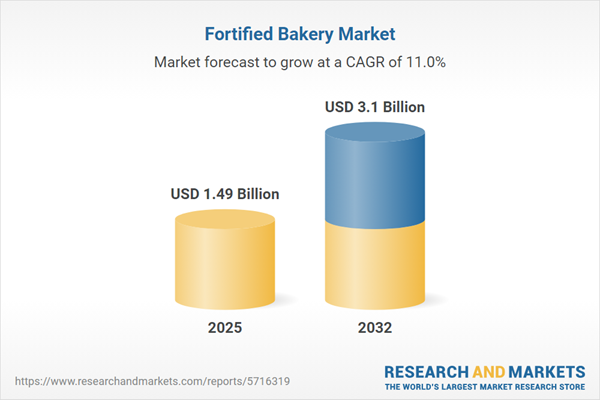Speak directly to the analyst to clarify any post sales queries you may have.
The fortified bakery market is rapidly transforming as manufacturers embrace health-driven innovation, new technologies, and precise market segmentation to meet rising demand for functional, convenient, and transparently sourced baked goods.
Market Snapshot: Fortified Bakery Market Trends & Growth
The Fortified Bakery Market grew from USD 1.34 billion in 2024 to USD 1.49 billion in 2025. It is expected to continue growing at a CAGR of 10.99%, reaching USD 3.10 billion by 2032. As consumer interest in wellness escalates, bakery producers are introducing value-added products with enhanced nutritional profiles to appeal to increasingly health-aware and convenience-seeking demographics. Core drivers include evolving dietary habits, increased interest in functional foods, and industry-wide moves towards ingredient transparency and clean-label claims.
Scope & Segmentation: Comprehensive Coverage Across the Global Fortified Bakery Market
This report provides in-depth analysis and forecasts across a broad spectrum of fortified bakery products, fortification technologies, channels, demographics, packaging formats, and regions. The market is segmented as follows:
- Product Types: Bread (including buns, rolls, and sliced bread), cakes (such as cupcakes, layer cakes, and pound cakes), cookies (biscuit cookies, chocolate chip cookies, sandwich cookies), crackers (flavored, salted, whole grain), and snacks (cereal bars, granola bars, muffins).
- Fortificant Types: Calcium (carbonate, tricalcium phosphate), fiber (inulin, oat fiber), iron (ferrous fumarate, ferrous sulfate), protein (soy, whey), plus vitamin D2 and D3.
- Distribution Channels: Convenience stores (corner shops, gas station outlets), online retail (brand websites, third-party marketplaces), specialty stores (health food stores, pharmacies), and supermarkets (hypermarkets, neighborhood supermarkets).
- End User Segments: Adults (students, working adults), children (grade school, preschool), and elderly groups (60–74, 75+).
- Packaging Types: Foil packaging (aluminum, laminated), paper packaging (kraft, paperboard), and plastic (HDPE, PET), each chosen for freshness, sustainability, or portability.
- Regions Covered: Americas (North and Latin America), Europe, Middle East & Africa (specific focus on leading economies and high-growth markets), Asia-Pacific (including China, India, Japan, Australia, and others) with country-specific trends and opportunities.
- Key Industry Players: Grupo Bimbo S.A.B. de C.V., Associated British Foods plc, Flowers Foods Inc., George Weston Limited, Britannia Industries Limited, Kellogg Company, General Mills Inc., Aryzta AG, Lantmännen ek. för, Grupo Nutresa S.A.
Key Takeaways: Strategic Insights Driving Fortified Bakery Success
- Health-driven consumers are propelling demand for bakery products enriched with micronutrients, protein, and specialty fibers, leading to highly differentiated product offerings.
- The integration of advanced food technologies, such as microencapsulation and precision fortification, supports nutrient stability and consumer-preferred sensory experiences.
- Clean-label trends and transparent ingredient sourcing are shaping purchasing decisions, pushing brands to innovate in fortification and labeling practices.
- Product development increasingly accounts for demographic diversity, with targeted solutions for various life stages—ranging from convenient snacks for professionals to bone-supporting options for seniors.
- Collaborations between food scientists, nutritionists, and marketers are enabling faster response to evolving wellness trends and regional market needs.
Tariff Impact: Navigating the 2025 United States Tariffs
The introduction of new United States tariffs in 2025 is shifting the competitive landscape. Manufacturers are adapting sourcing strategies by accelerating localization and re-evaluating ingredient selection to manage costs. Some have reformulated products, blending alternative fortificants, while others are building resilient supply chains through upstream partnerships and optimizing logistics to mitigate volatility and preserve margin integrity.
Methodology & Data Sources
Research incorporated a robust mixed-method approach: primary data was gathered from executive interviews across R&D, supply chain, and marketing functions, complemented by consumer surveys. Secondary sources included industry publications, regulatory guidelines, patent data, and proprietary market databases. Statistical modeling and cross-verification with external experts were used to ensure quality and accuracy.
Why This Report Matters: Actionable Advantages for Decision Makers
- Access to granular segmentation enables organizations to identify growth opportunities and tailor product innovations to specific consumer needs.
- Insight into regulatory, technological, and trade trends allows for strategic planning and risk mitigation across global operations.
- Detailed competitive intelligence informs strategic partnerships, investment decisions, and sustainable packaging initiatives aligned with evolving market expectations.
Conclusion
In a climate of rapid change, the fortified bakery market rewards innovation, operational agility, and a data-driven approach. Senior leaders equipped with strategic insights will position their organizations for long-term success in this evolving global marketplace.
Additional Product Information:
- Purchase of this report includes 1 year online access with quarterly updates.
- This report can be updated on request. Please contact our Customer Experience team using the Ask a Question widget on our website.
Table of Contents
3. Executive Summary
4. Market Overview
7. Cumulative Impact of Artificial Intelligence 2025
Companies Mentioned
The companies profiled in this Fortified Bakery market report include:- Grupo Bimbo, S.A.B. de C.V.
- Associated British Foods plc
- Flowers Foods, Inc.
- George Weston Limited
- Britannia Industries Limited
- Kellogg Company
- General Mills, Inc.
- Aryzta AG
- Lantmännen ek. för
- Grupo Nutresa S.A.
Table Information
| Report Attribute | Details |
|---|---|
| No. of Pages | 183 |
| Published | October 2025 |
| Forecast Period | 2025 - 2032 |
| Estimated Market Value ( USD | $ 1.49 Billion |
| Forecasted Market Value ( USD | $ 3.1 Billion |
| Compound Annual Growth Rate | 10.9% |
| Regions Covered | Global |
| No. of Companies Mentioned | 11 |









